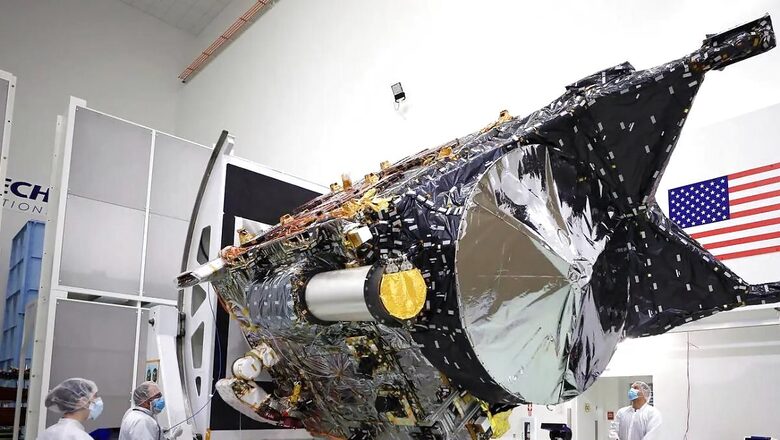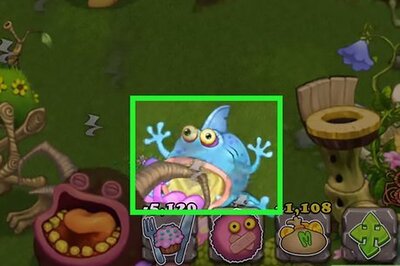
views
A NASA experiment on the Psyche spacecraft, which is on a mission to examine an asteroid, has successfully beamed back a near-infrared laser in a deep-space test.
The space agency on November 14 picked up a laser signal fired from an instrument that was launched with the Psyche spacecraft, which is currently more than 10 million miles from Earth and heading toward a mysterious metal asteroid.
The laser beam fired from Psyche spacecraft, named after the asteroid, is part of a scientific mission that NASA launched in October this year to explore Psyche, a giant metal rich asteroid, about three times farther away from the Sun than is Earth.
The main goal of the mission is studying the composition and structure of this asteroid, which could tell scientists more about Earth’s core since the two objects might have a similar makeup.
The spacecraft used the NASA’s first demonstration of optical communications beyond the Earth-Moon system called Deep Space Optical Communications (DSOC). As Psyche proceeds to the central asteroid belt between Mars and Jupiter, DSOC will be used to deliver high-bandwidth test data to our planet.
Why is Psyche Asteroid Valuable?
Psyche is a mission to study a metal-rich asteroid with the same name, located in the main asteroid belt between Mars and Jupiter, NASA said. It is the space agency’s first mission to study an asteroid that has more metal than rock or ice.
Scientists estimate that lots of these metals exist thousands of miles beneath Earth’s surface, in its molten core, but that’s far too deep and hot to mine.
If Psyche were mineable, its iron, nickel and gold deposits could be worth an eye-watering $10,000 quadrillion (that’s $10,000,000,000,000,000,000), according to an estimate by Forbes magazine. It likely contains platinum, nickel, iron and even gold.
However, the mission’s principal investigator Lindy Elkins-Tanton who was responsible for that calculation said it’s nothing more than a “fun intellectual exercise with no truth to it.”
“We have zero technology as a species to bring Psyche back to Earth,” she said in a recent briefing. Even if the endeavour were successful, it would flood the metals market, reducing their value to zero, she said.
The Psyche mission is a huge step in figuring out what sort of metals are out there, and it may also answer questions about the composition and properties of Earth’s core.
Significance of Laser-beam Experiment
With deep space missions demanding higher and higher data rates, NASA is turning to next generation communications based on lasers to complement radio-frequency based communications.
Psyche is carrying on board a technology experiment, to demonstrate a “10 times augmentation of traditional telecom data rates,” said Abi Biswas of NASA’s Jet Propulsion Laboratory — enabling the transmission of higher resolution images, more science data, and streaming video.
NASA is hoping to eventually use the technology on human missions to Mars.
What Will the Mission Find
The Psyche mission is a huge step in figuring out what sort of metals are out there, and it may also answer questions about the composition and properties of Earth’s core.
With the spacecraft estimated to arrive at the asteroid’s orbit in 2029, the findings from the Psyche mission will provide unique insights into the type of metals present on the asteroid’s surface, as well as their amount, and the minerals containing these metals.
This data is essential both for scientists like me exploring the formation and evolution planetary bodies, as well as for companies investigating the possibility of asteroid mining.
What to Know About Asteroid
Asteroids come in a variety of sizes. Some are the size of a town, while others are the size of a state. Most asteroids are made of rocks and represent the leftovers from the early formation of our solar system around 4.6 billion years ago.
Not every asteroid is the same – some, like Bennu, the target of NASA’s OSIRIS-REx mission, are rich in carbon. These are very old, and they will teach scientists more about how planets formed and how life may have begun on Earth.
Others, like Psyche, are made of metals and potentially result from one or more collisions between astronomical objects when the solar system was forming. These collisions left debris flying through space — including potential pieces of a planet’s metal-rich core. A NASA spacecraft will orbit and analyze the surface of Psyche.
(With inputs from agencies)
















Comments
0 comment